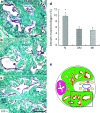Mobilisation of endothelial progenitor cells: one of the possible mechanisms involved in the chronic administration of melatonin preventing erectile dysfunction in diabetic rats
- PMID: 22367180
- PMCID: PMC3720169
- DOI: 10.1038/aja.2011.161
Mobilisation of endothelial progenitor cells: one of the possible mechanisms involved in the chronic administration of melatonin preventing erectile dysfunction in diabetic rats
Abstract
Diabetes-induced oxidative stress plays a critical role in the mobilisation of endothelial progenitor cells (EPCs) from the bone marrow to the circulation. This study was designed to explore the effects of chronic melatonin administration on the promotion of the mobilisation of EPCs and on the preservation of erectile function in type I diabetic rats. Melatonin was administered to streptozotocin-induced type I diabetic rats. EPCs levels were determined using flow cytometry. Oxidative stress in the bone marrow was indicated by the levels of superoxide dismutase and malondialdehyde. Erectile function was evaluated by measuring the intracavernous pressure during an electrostimulation of the cavernous nerve. The density of the endothelium and the proportions of smooth muscle and collagen in the corpus cavernosum were determined by immunohistochemistry. The administration of melatonin increased the superoxide dismutase level and decreased the malondialdehyde level in the bone marrow. This effect was accompanied by an increased level of circulating EPCs in the diabetic rats. The intracavernous pressure to mean arterial pressure ratio of the rats in the treatment group was significantly greater, compared with diabetic control rats. The histological analysis demonstrated an increase in the endothelial density of the corpus cavernosum after the administration of melatonin. However, melatonin treatment did not change the proportions of smooth muscle and collagen in the corpus cavernosum of diabetic rats. Chronic administration of melatonin has a beneficial effect on preventing erectile dysfunction (ED) in type I diabetic rats. Promoting the mobilisation of EPCs is one of the possible mechanisms involved in the improvement of ED.
Figures




Similar articles
-
Chronic prostatitis/chronic pelvic pain syndrome impairs erectile function through increased endothelial dysfunction, oxidative stress, apoptosis, and corporal fibrosis in a rat model.Andrology. 2016 Nov;4(6):1209-1216. doi: 10.1111/andr.12273. Epub 2016 Aug 27. Andrology. 2016. PMID: 27565759
-
Melatonin Treatment Ameliorates Hyperhomocysteinemia-Induced Impairment of Erectile Function in a Rat Model.J Sex Med. 2019 Oct;16(10):1506-1517. doi: 10.1016/j.jsxm.2019.07.003. Epub 2019 Aug 19. J Sex Med. 2019. PMID: 31439521
-
Panax notoginseng saponins improve erectile function through attenuation of oxidative stress, restoration of Akt activity and protection of endothelial and smooth muscle cells in diabetic rats with erectile dysfunction.Urol Int. 2014;93(1):92-9. doi: 10.1159/000354878. Epub 2014 Jan 23. Urol Int. 2014. PMID: 24458001
-
Melatonin prevents deterioration of erectile function in streptozotocin-induced diabetic rats via sirtuin-1 expression.Andrologia. 2020 Oct;52(9):e13639. doi: 10.1111/and.13639. Epub 2020 Jun 1. Andrologia. 2020. PMID: 32478903 Review.
-
Intracavernous administration of bone marrow mononuclear cells: a new method of treating erectile dysfunction?J Transl Med. 2013 Jun 9;11:139. doi: 10.1186/1479-5876-11-139. J Transl Med. 2013. PMID: 23758954 Free PMC article. Review.
Cited by
-
Therapeutic effects of adipose-derived stem cells-based microtissues on erectile dysfunction in streptozotocin-induced diabetic rats.Asian J Androl. 2017 Jan-Feb;19(1):91-97. doi: 10.4103/1008-682X.182817. Asian J Androl. 2017. PMID: 27345005 Free PMC article.
-
Knockdown of miR-423-5p simultaneously upgrades the eNOS and VEGFa pathways in ADSCs and improves erectile function in diabetic rats.J Cell Mol Med. 2021 Oct;25(20):9796-9804. doi: 10.1111/jcmm.16927. Epub 2021 Sep 20. J Cell Mol Med. 2021. PMID: 34545676 Free PMC article.
-
Clinical significance and expression of microRNA in diabetic patients with erectile dysfunction.Exp Ther Med. 2015 Jul;10(1):213-218. doi: 10.3892/etm.2015.2443. Epub 2015 Apr 22. Exp Ther Med. 2015. PMID: 26170937 Free PMC article.
-
Body fluid-derived stem cells - an untapped stem cell source in genitourinary regeneration.Nat Rev Urol. 2023 Dec;20(12):739-761. doi: 10.1038/s41585-023-00787-2. Epub 2023 Jul 6. Nat Rev Urol. 2023. PMID: 37414959 Free PMC article. Review.
-
Combined Transplantation of Adipose Tissue-Derived Stem Cells and Endothelial Progenitor Cells Improve Diabetic Erectile Dysfunction in a Rat Model.Stem Cells Int. 2020 Jul 3;2020:2154053. doi: 10.1155/2020/2154053. eCollection 2020. Stem Cells Int. 2020. PMID: 32714394 Free PMC article.
References
-
- Teles AG, Carreira M, Alarcao V, Sociol D, Aragues JM, et al. Prevalence, severity, and risk factors for erectile dysfunction in a representative sample of 3,548 Portuguese men aged 40 to 69 years attending primary healthcare centers: results of the Portuguese erectile dysfunction study. J Sex Med. 2008;5:1317–24. - PubMed
-
- Yang G, Pan C, Lu J. Prevalence of erectile dysfunction among Chinese men with type 2 diabetes mellitus. Int J Impot Res. 2010;22:310–7. - PubMed
-
- Giuliano FA, Leriche A, Jaudinot EO, de Gendre AS. Prevalence of erectile dysfunction among 7689 patients with diabetes or hypertension, or both. Urology. 2004;64:1196–201. - PubMed
-
- de Berardis G, Franciosi M, Belfiglio M, Di Nardo B, Greenfield S, et al. Erectile dysfunction and quality of life in type 2 diabetic patients: a serious problem too often overlooked. Diabetes Care. 2002;25:284–91. - PubMed
-
- Cho NH, Ahn CW, Park JY, Ahn TY, Lee HW, et al. Prevalence of erectile dysfunction in Korean men with type 2 diabetes mellitus. Diabet Med. 2006;23:198–203. - PubMed
Publication types
MeSH terms
Substances
LinkOut - more resources
Full Text Sources
Medical

